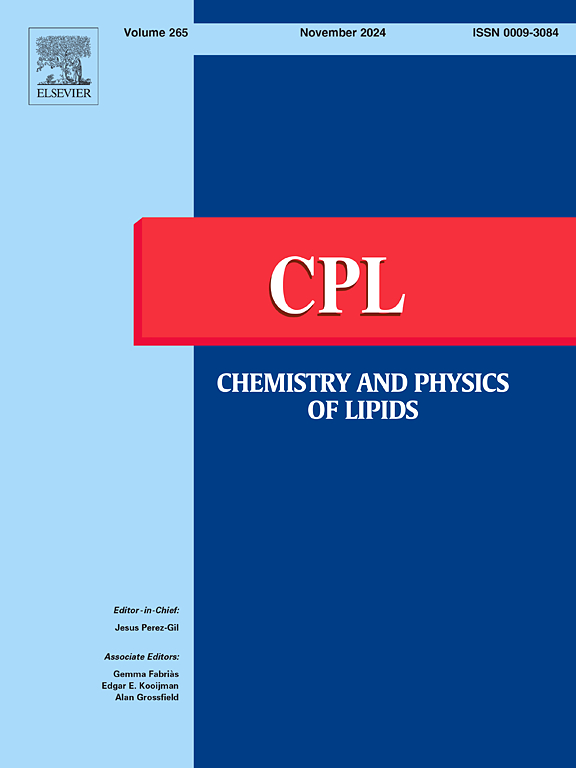从大肠杆菌中提取的氢磷脂和氘磷脂作为仿生细胞质细菌膜。
IF 2.8
3区 生物学
Q2 BIOCHEMISTRY & MOLECULAR BIOLOGY
引用次数: 0
摘要
通过细菌脂质提取物重建的模型脂质双层是研究细菌膜物理性质的可靠系统,例如,可以用于帮助设计新的抗生素。在这里,我们讨论了从大肠杆菌中生产氢和氘化甘油磷脂(GPL)提取物的方案的优化,并将其重组为模型膜。该方案通过引入额外的纯化步骤,确保GPL分子与其他膜组分(如中性脂类)的更好分离,从而与最先进的方法不同。用不同的分析方法对这些提取物的成分进行了表征。优化实验条件,以制备囊泡、空气/水界面脂质单层和支撑脂质双层形式的细菌膜模型。生物物理技术的结合,包括Langmuir等温线、中子反射法、带耗散监测的石英晶体微平衡和小角度x射线散射,提供了自组装结构的详细信息,并突出了氢和氘萃取物之间的有趣差异。总之,我们报告了提取和表征氢和氘化大肠杆菌GPL提取物的详细描述。研究这种复杂的脂质混合物对于重建高度生物相关的细菌膜模型非常重要,旨在了解细菌膜的生物学功能。本文章由计算机程序翻译,如有差异,请以英文原文为准。

Hydrogenous and deuterated phospholipid extracts from Escherichia coli as biomimetic cytoplasmic bacterial membranes
Model lipid bilayers, reconstituted by using bacterial lipid extracts, are reliable systems to investigate the physical properties of bacterial membranes, and can be used, for example, to aid the design of new antibiotics. Here, we discuss the optimisation of a protocol for the production of hydrogenous and deuterated glycerophospholipid (GPL) extracts from Escherichia coli, and their reconstitution into model membranes. This protocol stands apart from state-of-the-art methods by introducing an additional purification step, which ensures a better separation of the GPL molecules from other membrane components such as neutral lipids. The composition of these extracts was characterised with different analytical methods. Experimental conditions were optimised for producing bacterial membrane models in the form of vesicles, lipid monolayers at the air/water interface and supported lipid bilayers. A combination of biophysical techniques, including Langmuir isotherms, neutron reflectometry, quartz crystal microbalance with dissipation monitoring, and small angle X-ray scattering provided detailed information on the self-assembled structures, and highlighted interesting differences between hydrogenous and deuterated extracts. Altogether, we report a detailed description of extraction and characterisation of hydrogenous and deuterated E. coli GPL extracts. The study of such complex lipid mixtures is important to recreate highly biologically relevant bacterial membrane models for studies aimed at understanding the biological function of bacterial membranes.
求助全文
通过发布文献求助,成功后即可免费获取论文全文。
去求助
来源期刊

Chemistry and Physics of Lipids
生物-生化与分子生物学
CiteScore
7.60
自引率
2.90%
发文量
50
审稿时长
40 days
期刊介绍:
Chemistry and Physics of Lipids publishes research papers and review articles on chemical and physical aspects of lipids with primary emphasis on the relationship of these properties to biological functions and to biomedical applications.
Accordingly, the journal covers: advances in synthetic and analytical lipid methodology; mass-spectrometry of lipids; chemical and physical characterisation of isolated structures; thermodynamics, phase behaviour, topology and dynamics of lipid assemblies; physicochemical studies into lipid-lipid and lipid-protein interactions in lipoproteins and in natural and model membranes; movement of lipids within, across and between membranes; intracellular lipid transfer; structure-function relationships and the nature of lipid-derived second messengers; chemical, physical and functional alterations of lipids induced by free radicals; enzymatic and non-enzymatic mechanisms of lipid peroxidation in cells, tissues, biofluids; oxidative lipidomics; and the role of lipids in the regulation of membrane-dependent biological processes.
 求助内容:
求助内容: 应助结果提醒方式:
应助结果提醒方式:


